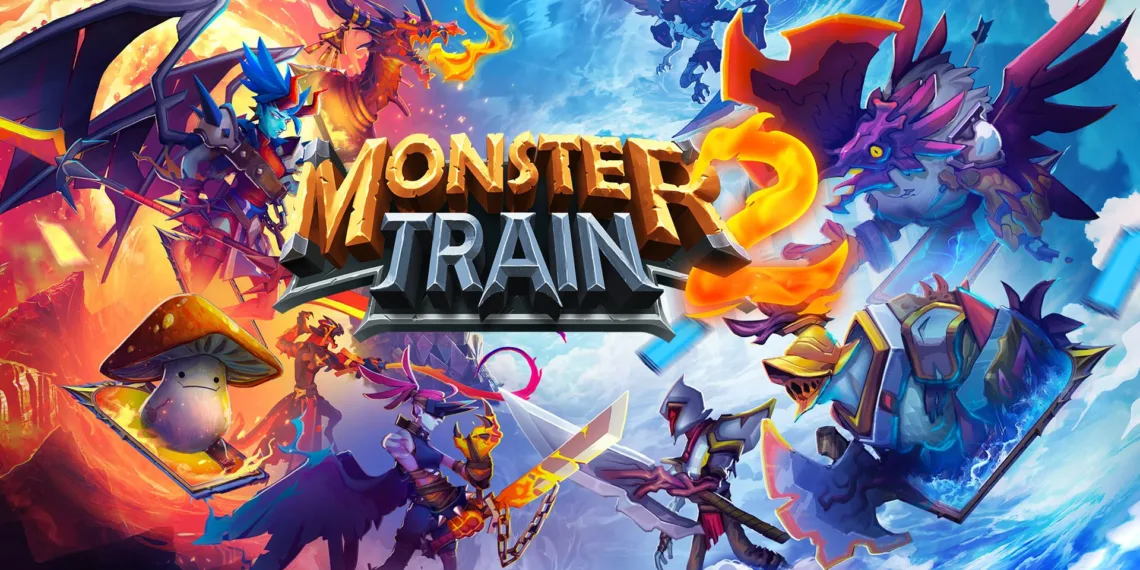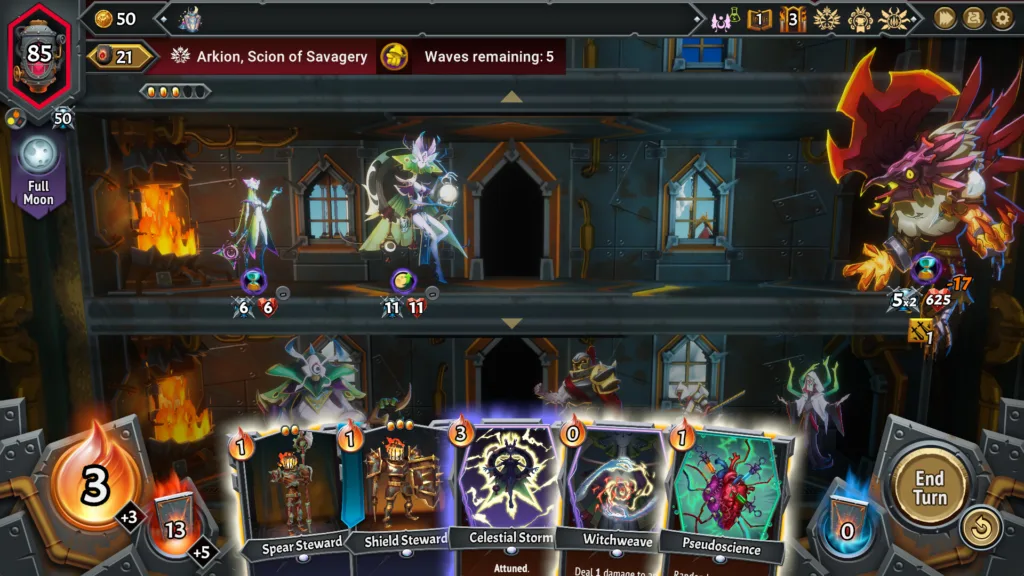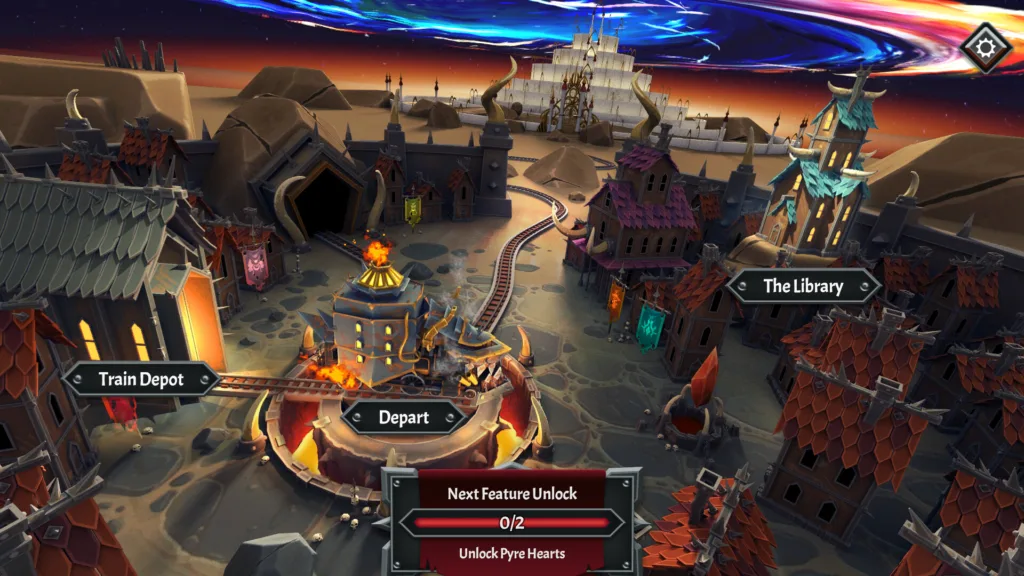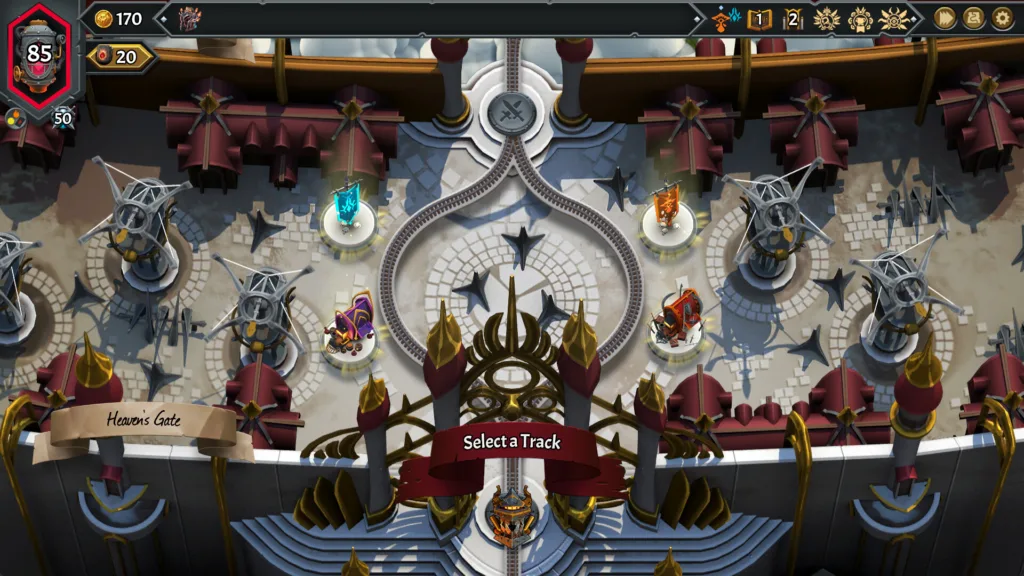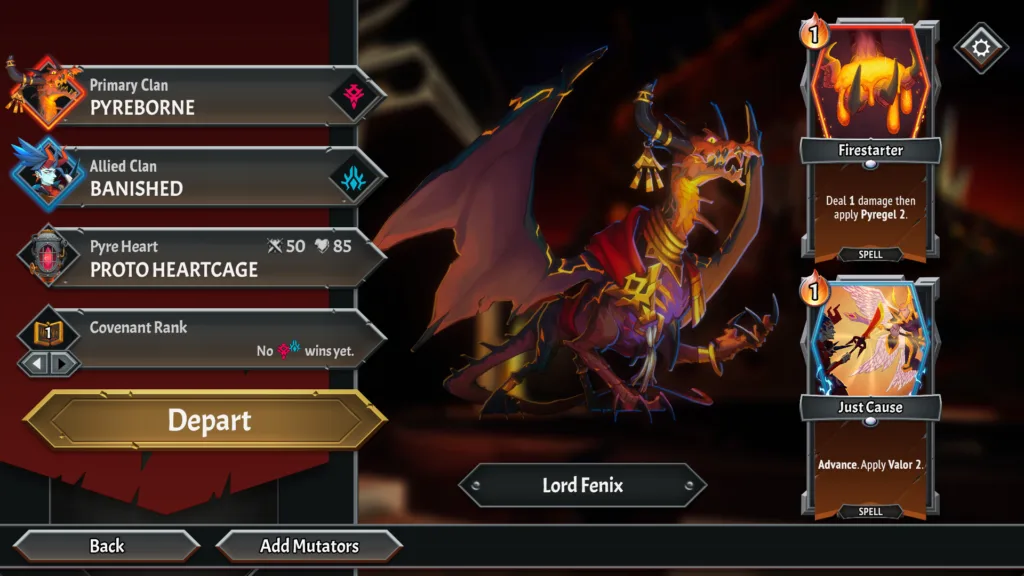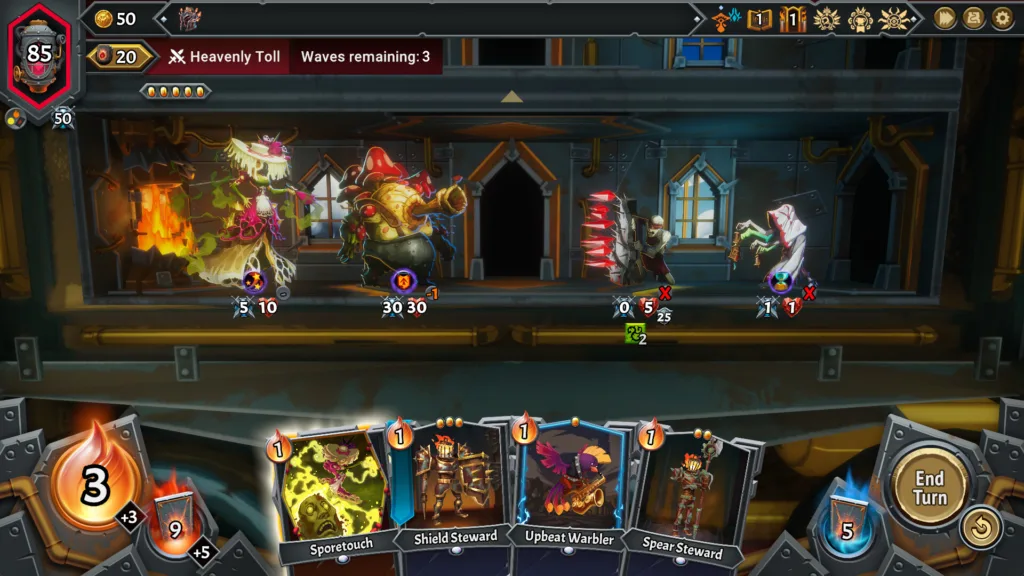The last embers of Hell are not for passive defense; they now fuel an audacious ascent. In Monster Train 2, the familiar descent into darkness is dramatically inverted. Players find themselves commanding an infernal locomotive, not on a path deeper into shadow, but on a relentless climb towards a Heaven that has itself become corrupted.
This is a strategic deckbuilding roguelike at its core, ingeniously fused with the pressing demands of multi-level tower defense. Your charge is to orchestrate a legion of monstrous units and potent spells across the train’s three distinct vertical battlefields.
Each confrontation requires careful placement and resource management, as you strive to protect your vital Pyre from determined celestial aggressors. The true spark ignites in the discovery of powerful card combinations, a system that teases the immense satisfaction of crafting a perfectly synchronized engine of destruction, different with every attempt to reach the heavens.
Anatomy of the Ascent
The battlefield itself is a unique vertical slice: your train comprises three distinct floors where combat unfolds, crowned by the all-important Pyre, your mobile heart. Enemies board at the ground level, a relentless tide of angelic or titanic forces that, if unchecked, ascend one floor each turn.
This structure transforms every encounter into an urgent spatial puzzle. Strategic unit placement becomes paramount; positioning resilient protectors to shield fragile, high-damage allies, or establishing devastating kill-zones on lower floors can mean the difference between a triumphant stand and a crumbling defense against foes with varying attack patterns and abilities.
Fueling these battles is a dynamic deckbuilding system. Each attempt begins with a pivotal decision: aligning with two of the game’s varied factions. This choice dictates your starting Champion—a powerful, evolving hero unit with distinct upgrade paths that significantly influence your early strategy—and the broader pool of cards you’ll draft from.
You’ll draw a hand of unit and spell cards, spending limited energy to deploy creatures or unleash tactical effects. The true art, and deep satisfaction, lies in cultivating potent synergies, weaving together disparate card abilities into a cohesive, sometimes overwhelmingly powerful force. A thoughtfully upgraded Champion, supported by a deck rich in complementary effects, can shift the tide of any engagement.
Between these fiery confrontations, the journey itself offers a constant stream of crucial choices. A branching map presents pathways laden with opportunity and peril: will you seek out merchants for new cards and vital unit upgrades, risk dangerous elite encounters for greater rewards like powerful artifacts, or find a quiet forge to duplicate your strongest assets or prune weaker cards?
Managing your gold for these enhancements and, critically, your Pyre’s health, becomes a constant balancing act. These decisions—which path to take, which cards to add, which to empower, and which to cull—are the moments where your overarching strategy takes shape, crafting a distinct narrative of power and adaptation for each perilous ascent.
New Blueprints for Infernal Strategy
Monster Train 2 layers several compelling systems upon its already robust foundation, each offering new avenues for player expression and strategic depth. Equipment cards introduce a welcome dimension of persistent unit customization. These are not fleeting spells but tangible augmentations you affix directly to your demonic warriors, granting anything from straightforward attack and health boosts to transformative traits like health-draining Lifesteal, retaliatory Spikes, or the ability for excess damage to Trample onto rear-line foes. The capacity to discover, select, and even combine these pieces allows for profound specialization, enabling you to sculpt a generic minion into a bespoke engine of destruction or an unyielding sentinel. This system encourages a forward-thinking approach to unit development.
Adding another layer to battlefield manipulation are Room Modifications. These single-play cards enchant an entire floor of your train with lasting effects. One level might become a zone where your units strike with increased ferocity, another could reduce the cost of all spells cast there, or you might even designate a floor that passively damages all its occupants—friend and foe alike—each turn. Such modifications demand careful consideration of your overall build, compelling you to dedicate specific train levels to particular combat roles or to exploit their unique environmental properties for a tactical edge.
Strategic planning is further amplified even before the first battle, through the selection of customizable Pyre Hearts. Instead of a one-size-fits-all engine, you can choose from a variety of hearts, each bestowing a unique passive advantage or a powerful, often once-per-battle, ability. One might grant bonus energy at a crucial juncture, another could alter the very cards you begin with, fundamentally reshaping your early game. This choice, made at the outset, immediately colors the character of the ensuing run.
Smaller, yet highly impactful, gameplay refinements also contribute to a more controlled experience. A guaranteed deployment phase at the start of each combat encounter mitigates the frustration of poor initial draws, ensuring you can always establish some board presence. Additionally, options to reset a turn or even restart an entire battle—though noted for scoring purposes—serve as invaluable tools for learning and experimentation, permitting recovery from minor tactical missteps.
Architects of Ruin and Redemption
The strategic heart of Monster Train 2 pulses with the introduction of five entirely new factions, each a cleverly designed tapestry of thematic abilities and distinct visual identities. These are not mere reskins of old concepts; they introduce fresh playstyles and mechanical interactions that dramatically alter your approach to both deck construction and battlefield presence, forming the core of countless strategic experiments.
The Pyreborne are avaricious, fire-wielding dragons who quite literally weaponize wealth. Their units often generate gold through combat via the Avarice keyword, which can be spent on powerful upgrades or contribute to their Dragon’s Hoard for unique, escalating rewards. They also specialize in applying Pyregel, a debuff that makes afflicted enemies increasingly susceptible to incoming damage, allowing for potent offensive scaling, often culminating in fiery retribution with their golden egg mechanics.
Representing fallen celestials now fighting alongside Hell’s legions, the Banished bring a dynamic, often aggressive, style to the conflict. Their core mechanic, Valor, empowers units with stacking attack power and, for those brave enough to hold the front line, armor. Many Banished units thrive on movement between floors or combat positions, creating a highly mobile fighting force, while some grow stronger by taking hits through the Revenge keyword, turning them into formidable, self-buffing combatants.
The Underlegion are unsettling masters of fungal proliferation and creeping decay. They can overrun entire floors by spawning numerous, initially weak Funguy soldiers that stack upon each other to become surprisingly resilient and powerful. Complementing this overwhelming numbers game is their mastery of Decay, a persistent damage-over-time effect. Their true strength lies in the synergy between rapidly summoning their fungal hordes and simultaneously applying these debilitating debuffs.
Embodying reckless scientific endeavor and a morbid fascination with undeath, the Lazarus League is intrinsically tied to the new Equipment system. Their ranks include frail, almost disposable units that bequeath valuable gear upon their demise, encouraging almost sacrificial plays. Their Reanimation keyword brings fallen units back for another go, while their access to potent, mixable potions can grant temporary, game-changing buffs or debilitating effects to friend or foe.
Finally, the enigmatic Luna Coven wields magic intrinsically tied to the ever-shifting Moon Cycle. Different lunar phases empower specific units or spells, demanding careful timing and even direct manipulation of the cycle itself. They also utilize Conduit, a stacking effect that amplifies spell power on a given floor, turning their mages into devastating arcane artillery when properly supported by units that benefit from, or trigger, phase changes.
The true genius, however, emerges when you combine any two of these disparate factions. A Pyreborne’s relentless gold generation might fund an expensive Lazarus League equipment strategy, or the Underlegion’s numerous disposable bodies could provide ample fodder to trigger a Banished champion’s powerful abilities. Discovering these inter-clan synergies is a core part of the game’s deep and enduring appeal, constantly presenting new strategic puzzles and pathways to constructing an overwhelmingly effective force.
The Long Haul: Trials and Triumphs
Victory in Monster Train 2 is merely the gateway to a significantly longer and more arduous campaign against the celestial forces. The Covenant system provides a structured path for players to escalate the challenge systematically. With each rank achieved after a successful run, new, demanding modifiers are introduced—tougher enemy waves, more restrictive resource availability, or uniquely powerful boss variants—compelling players to refine their strategies and deepen their understanding of card interactions.
This progressive difficulty ensures the core strategic puzzle remains engaging, constantly evolving to test one’s mastery. Beyond the primary campaign and its scaling Covenant ranks, a variety of game modes offer diverse tactical experiences. Daily Challenges inject a dose of unpredictability with pre-set, often dramatic, rule-altering mutators, providing a fresh test each day.
Dimensional Challenges present meticulously crafted scenarios with specific objectives and unconventional rule sets, often compelling players to leverage particular mechanics or faction combinations in inventive ways; these can feel like intricate puzzles or advanced strategic exercises. For those who craft truly formidable builds, an Endless Mode awaits after the standard final boss, pitting players against increasingly overwhelming opposition until their meticulously constructed engine eventually succumbs.
This persistent engagement is rewarded through a steady stream of unlockable content. New cards for each faction, powerful artifacts capable of redefining entire strategies, additional Pyre Hearts that offer novel starting conditions for future runs, and even cosmetic options for customizing your train become available through continued play and the completion of specific milestones. This constant drip-feed of new tools and strategic possibilities provides strong incentives to return to the tracks, experiment with fresh approaches, and explore the myriad synergies the game holds.
Crafting the Crusade’s Character
Visually, Monster Train 2 embraces a vibrant, cartoonish aesthetic that cleverly juxtaposes its demonic and celestial subject matter with an accessible charm. Unit designs are a highlight, each monster and angelic adversary exuding distinct personality, from mischievous imps to stern, imposing seraphs.
This creativity aids in quick identification on a busy battlefield. Despite the potential for screen-filling chaos as numerous effects and units vie for attention, the interface remains commendably clear, generally allowing players to parse complex board states and make informed decisions even under pressure.
The auditory landscape complements this visual energy effectively. An upbeat, often surprisingly jaunty, soundtrack propels the action, injecting a sense of rollicking adventure into your infernal crusade. Spell effects and the thud of combat carry appropriate weight, reinforcing the impact of your strategic choices and contributing to the satisfying rhythm of play without becoming overly distracting or cacophonous.
Narrative elements frame the central premise of Hell’s forces ascending to challenge a corrupted Heaven. These story threads are primarily delivered through visual novel-style cutscenes that appear between runs. The tone here is a curious mixture: serious plot points involving fallen angels and divine power struggles sit alongside more lighthearted, character-driven interactions among the diverse monster factions. Engagement with these story vignettes is largely at the player’s discretion, offering thematic context for those interested, while allowing players focused purely on the strategic gameplay to readily bypass them.
An Ever-Burning Infernal Flame
Monster Train 2 consistently stimulates the strategic mind through its relentless cascade of critical decisions. From the initial commitment to allied clans and a Champion’s developmental path, straight through to the urgent tactical choices made on each floor of your embattled train, every player action directly shapes the potential for triumph.
There’s a distinct intellectual thrill in unearthing a potent combination of cards, artifacts, and unit abilities—that crystallizing moment when disparate elements align to forge an almost unstoppable force. Witnessing a carefully cultivated synergy dismantle a previously overwhelming wave of angelic adversaries offers a potent and recurring satisfaction.
The sheer breadth of interactive elements—across the varied factions with their distinct mechanics, countless card interactions, escalating Covenant challenges, and diverse game modes—ensures that no two ascents towards the corrupted Heaven feel quite the same. This vast combinatorial space is a fertile ground for endless experimentation and strategic refinement.
Those who revel in intricate tactical puzzles, the creative expression found in deck construction, and the persistent pursuit of mastering complex, interlocking systems will discover a deep and captivating experience here. It is a design that profoundly rewards thoughtful engagement and beckons players back for repeated explorations of its rich strategic landscape.
The Review
Monster Train 2
Monster Train 2 masterfully builds upon its predecessor, offering an incredibly rich and replayable strategic deckbuilding experience. Its new clans, innovative mechanics like Equipment and Room cards, and deep synergies provide countless hours of engaging tactical puzzles. While the story is a light touch, the core gameplay is an exceptional infernal engine of addictive fun, making each ascent a fresh and rewarding challenge.
PROS
- Exceptional strategic depth and tactical variety
- Massive replayability through clans, covenants, and modes
- Brilliantly designed card and faction synergies
- Clever and impactful new mechanics enhance gameplay
- Highly engaging and satisfying core loop
CONS
- Narrative elements are quite light and may not engage all players
- The sheer number of interacting systems can initially feel daunting
- Visual novel cutscenes can seem a bit perfunctory








































